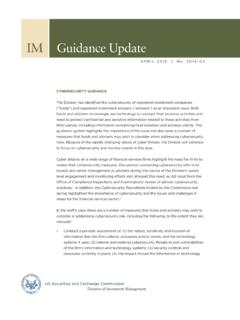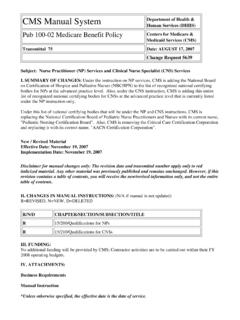Transcription of INDG367 - Inspecting fall arrest equipment made from ...
1 Health and Safety Executive Inspecting fall arrest equipment made from webbing or rope Health and Safety Executive Introduction Inspecting fall arrest equipment made from webbing or rope This leaflet is mainly aimed at employers who are responsible for the use of fall arrest equipment incorporating energy-absorbing lanyards made from webbing. It gives generic advice on inspection regimes for this equipment where it is used to provide protection against falls from a height. However, many of the principles can also be applied to non-energy-absorbing lanyards and safety harnesses used for the same purpose. They can also be applied to similar equipment made from rope. The leaflet does not cover other equipment such as anchor points. Employers should consult the manufacturer and/or supplier of the equipment for any product- specific inspection requirements.
2 An energy-absorbing lanyard is a line for connecting a full body harness to an This is a web-friendly version 11261 1 17/2/09 10:15:36 anchorage point with an inbuilt device that reduces the impact of a fall. There is a of leaflet INDG367 wide range of possible causes of degradation of synthetic fibres used in webbing and rope lanyards (including abuse, general wear and tear, edge/surface damage, ultraviolet light, dirt, grit, chemicals). Research involving synthetic fibre webbing lanyards has confirmed a number of the potential causes of degradation. It also highlighted that there is no well-defined boundary (eg usable life) separating those lanyards that are safe and those that are not (eg a 1 mm cut in the edge of a lanyard can result in a 5 to 40% loss of strength depending on the make of lanyard being used).
3 It is therefore essential that if lanyards are to be maintained to provide the required level of protection they are subject to an effective inspection regime. Legal requirements and standards The Personal Protective equipment at Work Regulations 1992 (as amended). require employers to maintain fall arrest equipment in good repair, including appropriate replacement. In addition, the Work at Height Regulations 2005 require that equipment which is exposed to conditions causing deterioration which is liable to result in dangerous situations should be inspected at suitable intervals and each time exceptional circumstances which might jeopardise safety have occurred. BS EN 365:2004 Personal protective equipment against falls from a height. General requirements for instructions for use, maintenance, periodic examination, repair, marking and packaging gives general requirements for periodic inspection, instructions for use and marking of PPE against falls from a height.
4 To counter the causes of degradation listed in the Introduction, the British Standard states that components should be examined at least twelve-monthly'. This is sometimes taken to be annually', although manufacturers of textile products usually recommend inspection more frequently than this. Page 1 of 6. Health and Safety Executive Inspection regime The inspection regime recommended in this leaflet has been discussed with representatives of manufacturers, suppliers, installers and major users via the British Standards Institution Technical Committee PH/5 (industrial safety belts and harnesses), the British Safety Industry Federation Height Safety Group and the Work at Height Safety Association. Employers should establish a regime for the inspection of lanyards that is drawn up by a competent person.
5 The regime should include: the lanyards to be inspected (including their unique identification);. the frequency and type of inspection (pre-use checks, detailed inspection and, where appropriate, interim inspection);. designated competent persons to carry out the inspections;. action to be taken on finding defective lanyards;. means of recording the inspections;. training of users; and a means of monitoring the inspection regime to verify inspections are carried out accordingly. It is essential that the person carrying out any inspection is sufficiently independent and impartial to allow them to make objective decisions, and has appropriate and genuine authority to discard defective lanyards. This does not mean that competent persons must necessarily be employed from an external company, although many manufacturers and/or suppliers offer inspection services and training in the inspection of their products.
6 Employers may wish to provide additional lanyards to use as replacements in the event that defective lanyards have to be taken out of use. Lanyards that are on hire may need special consideration, to ensure that they are subject to detailed inspections (and interim inspections if appropriate) within the period specified in the regime. Hirers should be informed of any use or damage that may affect the safety of the equipment (eg use with chemicals). Scope of the inspection regime Lanyards should be subject to: pre-use checks;. detailed inspections; and (as appropriate) interim inspections;. These should be carried out by competent persons, to identify defects or damage that may affect safety. Pre-use checks These checks are essential and should be carried out each time, before the lanyard is used.
7 Pre-use checks should be tactile and visual. The whole lanyard should be subject to the check, by passing it slowly through the hands (eg to detect small cuts of 1 mm in the edges, softening or hardening of fibres, ingress of contaminants). A visual check should be undertaken in good light and will normally take a few minutes. Inspecting fall arrest equiment made from webbing or rope Page 2 of 6. Health and Safety Executive detailed inspections These more formal, in-depth inspections should be carried out periodically at minimum intervals specified in the employer's inspection regime. It is recommended that there is a detailed inspection at least every six months. For frequently used lanyards it is suggested that this is increased to at least every three months, particularly when the equipment is used in arduous environments (eg demolition, steel erection, scaffolding, steel skeletal masts/towers with edges and protrusions).
8 detailed inspections should be recorded. Interim inspections These are also in-depth inspections and may be appropriate in addition to pre- use checks and detailed inspections. Interim inspections may be needed between detailed inspections because the employer's risk assessment has identified a risk that could result in significant deterioration, affecting the safety of the lanyard before the next detailed inspection is due. The need for and frequency of interim inspections will depend on use. Examples of situations where they may be appropriate include: risks from transient arduous working environments involving paints, chemicals or grit blasting operations; or acidic or alkaline environments if the type of fabric the lanyard is made from cannot be determined (some fabrics offer low resistance to acids or alkalis).
9 The results of interim inspections should be recorded. Examples of defects and damage The following defects and damage have the potential to result in the degradation and/or weakening of the lanyard: cuts of 1 mm or more at the edges of webbing lanyards (eg where the lanyard may have been choke-hitched around steelwork);. surface abrasion across the face of the webbing and at the webbing loops, particularly if localised;. abrasion at the edges, particularly if localised;. damage to stitching (eg cuts or abrasion);. a knot in the lanyard, other than those intended by the manufacturer;. chemical attack which can result in local weakening and softening often indicated by flaking of the surface. There may also be a change to the colour of the fibres;. heat or friction damage indicated by fibres with a glazed appearance which may feel harder than surrounding fibres.
10 UV-degradation which is difficult to identify, particularly visually, but there may be some loss of colour (if dyed) and a powdery surface;. partially deployed energy absorber (eg short pull-out of tear webbing);. contamination (eg with dirt, grit, sand etc) which may result in internal or external abrasion;. damaged or deformed fittings (eg karabiners, screwlink connectors, scaffold hooks);. damage to the sheath and core of a kernmantel rope (eg rucking of the core detected during tactile inspection);. internal damage to a cable-laid rope. Inspecting fall arrest equiment made from webbing or rope Page 3 of 6. Health and Safety Executive Withdrawing lanyards from use Lanyards should be withdrawn from use and passed to a competent person for a detailed inspection to decide whether they should continue to be used, destroyed or returned to the manufacturer for testing* to enable a product performance history to be determined, if: there is no evidence that a lanyard has been inspected by a competent person within the last six months.














